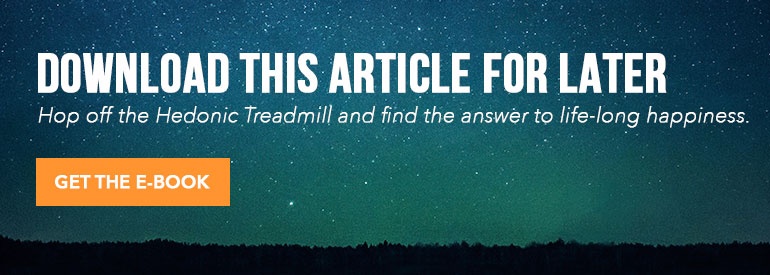 Reading Time: 14 minutes
Reading Time: 14 minutesAn Answer to Materialism, Consumerism (and That Nagging Feeling That Your Next “Big Win” Won’t Actually Make You Happy)
Do you feel like life is a constant game of catch-up?
That no matter how much you try to achieve, it never seems enough? And while you strive to live a better life, make more money, get more done, have nicer things, build a better body, and develop as a person, you’re still waiting for happiness to hit?
Like happiness is just around the corner…if only you could do a little more?
This feeling of not being, having, or doing enough is common in today’s consumerist culture. We’re encouraged to seek out success, wealth, fame, and material possessions, against which we measure our status, self-worth, and happiness.
And it seems no matter how much we strive to get and do, society tells us we need to do or have more before we can be happy.
In reality, most of us live in a world of overabundance.
We have more than enough to meet our basic needs of food, warmth, and safety. We’re surrounded by the latest gadgets and newest technology; we have closets full of clothes; our food is fast, convenient, and mass-produced; our houses our stocked with labor-saving devices; we have easy access to more information than we could ever need or want; and, compared to developing countries, we have employment opportunities and sufficient financial resources to live comfortably.
Yet, despite all of this, many of us still don’t feel happy.
We’re convinced that if we could just get the next “thing,” our lives would be better.
So, if having, doing, and being more isn’t the answer to happiness…what is?
The Answer to Happiness: The Philosophy of Enough
The Philosophy of Enough is a recognition that right now:
- You have enough.
- You do enough.
- You are enough.
It’s an acknowledgement that you have everything you need in this moment, and that you have the capability to meet your future needs.
The concept of “enough” allows you to be happy right now. Not when you get a new job, or lose weight, or find a partner. “Enough” is a brand of happiness that doesn’t rely on future-based promises of having, being and doing more. In fact, living in the future is a sure-fire way to sabotage your current levels of happiness — you can’t be happy right now if you’re worried about what’s next.
Instead, the Philosophy of Enough recognizes that you already have enough to bring happiness. It creates an understanding of what you really need to enjoy life, and helps you differentiate between genuine desires and mindless consumerism.
Sounds good, right? It may also sound a little radical considering society’s messages to chase “more.”
With that in mind, this article (and the free eBook you have the option to download) will walk you through the steps to developing the Philosophy of Enough in your own daily life:
- Understand the pitfalls and myths of chasing “more” to feel better
- Examine why more money won’t necessarily equate with more happiness
- Explore the psychology of scarcity, abundance, and the “enough” mindset
- Introduce the paradigm-busting importance of gratitude
This eBook will also give you practical tips on how to break the cycle of “more-is-better” by implementing the Philosophy of Enough into your life, so you can be happy — right now.
So, let’s get started…

Step 1: Understand the Hedonic Treadmill
“If a little is not enough for you, nothing is.” — Epicurus
Many of us live by the belief that we’ll be happy when we reach certain milestones:
- A new house
- A better job
- More money
- A new partner
- A better car
- Having kids
- A better body
- Going on vacation
We continually strive to achieve these things, but when we get them, we may only feel a fleeting sense of happiness before setting our sights on the next thing.
It’s not that these events or things don’t make us happy — to a certain extent they do. Rather, the levels of happiness we receive tend to be less than we expected, or those feelings of happiness don’t last as long as we believed they would. So, we seek out the next big thing and hope it will give us that elusive boost of long-lasting happiness.
The reason this approach to happiness lands short is due to a concept called Hedonic Adaption (or the Hedonic Treadmill). Hedonic Adaption means that we acclimatize to feelings of happiness over time, and that to feel the same level of happiness next time, we’ll need a stronger stimulus.
It also means that — regardless of what we do, get, or have — our happiness levels eventually return to a baseline set-point.

Put simply, jumping on our Hedonic Treadmill and chasing the next feel-good experience does little for our levels of happiness. We may keep pursuing, achieving, and striving, yet never reach those intense feelings of long-lasting happiness we’re told we should crave. If we remain stuck in this cycle, we’ll continue to believe that the next big thing will finally deliver a sense of fulfillment. Unfortunately, it rarely does.
How to Know If You’re Stuck on the Treadmill
- You ardently believe you’ll be happy when you: buy a new house/get a new job/have a better body/find a new partner.
- You focus all your energy on achieving a certain goal — reach it — then feel a bit empty inside. To make yourself feel better, you strive for another, bigger goal.
- You find yourself buying the latest gadgets and technology, convinced they’ll boost your quality of life, but they don’t seem to make you feel as happy as you’d hoped.
- You spend months planning and anticipating a big event, feeling certain it will boost your happiness. Afterward, you feel much the same as you did before.
- You work hard at getting a promotion at work. Then you get it — and feel great — but your happiness levels revert to your pre-promotion levels.
- The “buzz” from buying new things has faded over time, and you find you need a bigger or more expensive purchase to get the same buzz.
- You spend your work days waiting for the next vacation to arrive, so you can “finally” relax and be happy.
- You compare your lifestyle to others around you, and feel your life is lacking unless you can have the same clothes/house/body/car/job/social media following they do.
Step 2: Take Another Look at the Money = Happiness Myth
Many of us believe we’ll be happier when we have more money. From the beginning of our working lives, we strive to get better jobs, climb the corporate ladder, earn bonuses, and make six-figure salaries because we think those financial gains will enhance our happiness levels.
But this pursuit of money often comes at the sacrifice of our physical, mental, and emotional health and well-being. Being caught up in the “rat-race” can leave little time to focus on the things that truly enhance our quality of life, including being fit, healthy, nourished, and present enough to do the things that bring us joy.

There’s no denying money is an important part of Western Society and having a degree of financial stability enhances our capacity to enjoy life. However, our consumerist culture emphasizes that having more money is better — we’re told we can never get enough of it.
Whether it’s earning the large salary; having the resources to buy big houses, cars, and boats; investing in stocks and shares; or being able to indulge in a luxurious lifestyle — Western Society places a high value on being wealthy (and displaying that wealth).
Which brings us to the question: does money buy happiness?
Much has been said and written about this topic and the research points to a number of interesting conclusions:
Yes, there are correlations between income levels and reported levels of happiness. Which make sense — if we have sufficient income to afford nutritious food, quality healthcare, and fulfilling leisure activities, while also providing a buffer against unexpected expenses, illnesses, and economic downturns — then we’ll feel more satisfied with our lives.
Beyond a certain income level, though, the link between money and happiness becomes weaker. If we’re poor and unable to afford a comfortable existence, then having more money will lead to greater happiness. But if we can already afford to live comfortably, then having more money won’t necessary lead to more happiness.
In fact, the luxuries that come with having more money can be offset by negative factors such as longer work hours, higher responsibilities, increased stress and mental load, and less time to spend with family and friends or on leisure activities. Additionally, with all the trappings of wealth, those with higher incomes tend to find less enjoyment in life’s simple pleasures.
Symptoms That You’ve Fallen for the Money = Happiness Myth
- You think the more you earn, the happier you’ll be.
- You tend to use money to buy material goods, rather than experiences.
- You sacrifice time for hobbies and leisure activities in the pursuit of money.
- With each pay raise your expenses also increase, fueling the desire to earn even more.
- You feel like you can’t be happy unless you earn a certain wage or hold a position of prestige.
- You neglect your health to make time for the longer commutes and later work hours of higher-paid positions.
- You feel worried about missing an important meeting or call because “time is money.”
- Work events become a priority over relationships, social events, or family occasions,
- You find yourself skipping gym sessions or eating convenience food at your desk in order to work harder, earn a bonus, or get a promotion.
Step 3: Moving Your Mindset from Scarcity to Abundance
If you’ve recognized yourself as being on the Hedonic Treadmill or buying into the Money = Happiness Myth, you’re not alone. It’s a common experience in our consumerist culture. So, why do we act this way?
Much of it comes down to our mindset — that is, whether we view the world from a scarcity or abundance perspective.
The scarcity mindset is based on the presumption that resources are limited and there’s only a certain amount of time, money, possessions, and experiences to go around. So, if we don’t get something, then another person will, and that opportunity will be lost to us forever.

This way of thinking is characterized by the fear of not having enough, the fear of what the future holds, and the fear of survival. It drives the urge to get more of something in case that thing runs out or we need it in the future. It also emphasizes short-term decision making and tends to induce worry about what could happen, rather than what is actually happening now.
As a result, the scarcity mindset narrows our thinking patterns. We tend to only think about what we don’t have and how we can get more of it — whether that’s possessions, money, time, health, jobs, or relationships. This reduced perspective limits our ability to respond to present circumstances and reduces our capacity to problem-solve or think creatively about challenges.
This mindset can also reinforce feelings of inadequacy, anxiety, and low self-worth, while causing physiological symptoms associated with stress — such as increased blood pressure, raised heart and breathing rates, poor sleep patterns, and low mood.
But there is a different perspective we can take.
The abundance mindset is based on the belief that we have enough, we do enough, and we are enough. This mindset recognizes there are plenty of resources to spare and we can all have our share, whether that’s now or in the future.
This way of thinking opens us up to possibilities, creative solutions, and opportunities, and comes from a place of strong self-worth. It also helps promote positive feelings toward others, because we’re more likely to be happy for another’s achievements if we don’t feel like it reduces our piece of the pie.
When we operate from an abundance perspective, we feel more empowered and energized and look forward to the future. We tend to feel more relaxed, open, and clear-minded. We listen more deeply. We notice opportunities and think in a more flexible and adaptive manner.
Those with an abundance mentality experience the same challenges, setbacks, and problems as those with a scarcity mentality, but they view these challenges through a different lens — one that sees them in the driver’s seat of their life with a choice on how they respond to that situation.
So, how do we get our heads from scarcity to abundance?

Step 4: Pulling It Together with Gratitude
So far, we’ve learned that:
- Chasing more in the belief that “I’ll be happy when…” doesn’t bring expected levels of happiness due to hedonic adaption.
- The link between money and happiness isn’t as strong as we like to think it is.
- Viewing the world through a scarcity lens reinforces feelings of inadequacy, stress and worry.
How, then, do we move from a “more is better” mentality to the Philosophy of Enough?
It turns out that one of the biggest influences on happiness is the practice of gratitude. That is, being grateful that we have enough, we do enough, and we are enough.
Gratitude is an appreciation, a recognition, and an acknowledgement of what we already have, which turns our mind away from scarcity and toward abundance. Being grateful brings us back from future-based worry, insecurity, and inadequacy and teaches us to recognize what we have — right now — in the present moment.
Gratitude also helps us appreciate the little things that bring us joy and pleasure — from the juicy bite of an apple, to the sound of laughter, or the warmth of a blanket on a cool morning. And it’s appreciating these small, simple pleasures — which we often dismiss or forget — that lifts our daily happiness levels more than the big, one-off life events.
In other words, if we can enjoy our everyday activities, we’ll feel happier than if we waited for the “I’ll be happy when…” events.
With that in mind, the next few pages include tips and tools to help you bring gratitude into your life, enjoy the little things, and be happy with what you’ve got.

Tips for Being Happy with What You’ve Got
How to Change Your Mindset
- Have appreciative conversations. Ask a friend what has gone well in the past week and talk about what they’ve achieved (rather than what has gone wrong for both of you).
- Become aware of the role advertising and marketing plays in creating a scarcity mentality and choose to reduce your exposure to styles of media that promote this.
- Write yourself a reminder note and stick it somewhere noticeable: “You are enough, you have enough, you do enough.”
- Express your thoughts and feelings. whether verbally or creatively (being stuck in past moments stops us from experiencing the present and looking forward to the future).
- Open your posture upward and outward — it can boost your mood and clear your mind.
- Be patient with yourself. Accept that finding and living with “enough” is a process, not a destination or an end-point.
- Ask yourself a simple question: “What’s one good thing I haven’t yet noticed today?”
- When you feel an urge to do more, buy more, and or have more, take a moment to distinguish whether that feeling is a genuine need, or a want, or an obligatory “should.”
- Spend your money on small, moderate experiences rather than big events or possessions — frequent positive experiences are more gratifying than single intense experiences.
- Give yourself permission to be human and accept your emotions, thoughts and feelings (trying to get rid of them can lead to frustration or self-judgment).
- If you notice that you compare yourself to others — pause and appreciate your achievements.
- Write down three great things about your day.
- Focus on doing one thing at a time, without the distraction of multi-tasking.
How to Enjoy the Simple Things
- Call a friend and ask how you can help them today.
- Play with your kids (or a pet).
- Work with your hands — try gardening, baking, or woodworking.
- Listen to your favorite song.
- Visit an art gallery and appreciate the diversity of styles.
- Read a good book or watch a great film.
- Enjoy a warm bath.
- Sing in a choir, with a crowd, or in your car.
- Dance while you vacuum.
- Travel to a different part of your town and explore it through the eyes of a stranger.
- Make a donation to your favorite charity.
- Vigorously shampoo your hair while singing in the shower.
- Volunteer or do a community service in your neighborhood.
- Clear out your closet and give away unwanted items.
- Spend 5 minutes sitting quietly.
- Go on a date with your partner. If you’re single, take yourself or go with a friend.
- Have a conversation with a neighbor or a work colleague.
- Take 5 deep breaths and smile on each exhale.
- Spend 10 minutes looking through your favorite photos.
- Take a walk outside in the fresh air (ideally in the sunshine.

Conclusion: What Is Your Philosophy of Enough?
Happiness is a personal journey and one based on your unique feelings of satisfaction and contentment. So, treat the above tips as experiments — try them out, be curious about the results, and notice the difference in your happiness levels.
Perhaps start with one tip from each list and practice them regularly for a month to see how they feel for you.
Adopting the Philosophy of Enough is a process, and there’s likely to be obstacles along the way. Keep in mind that you’re overcoming a lifetime of ingrained social norms, consumerist programming, and cultural expectations.
But realizing you have enough, right now, to be happy is a game-changer.
No longer will you link your self-worth and happiness to doing, being, and having more. And that’s a journey worth taking.
















